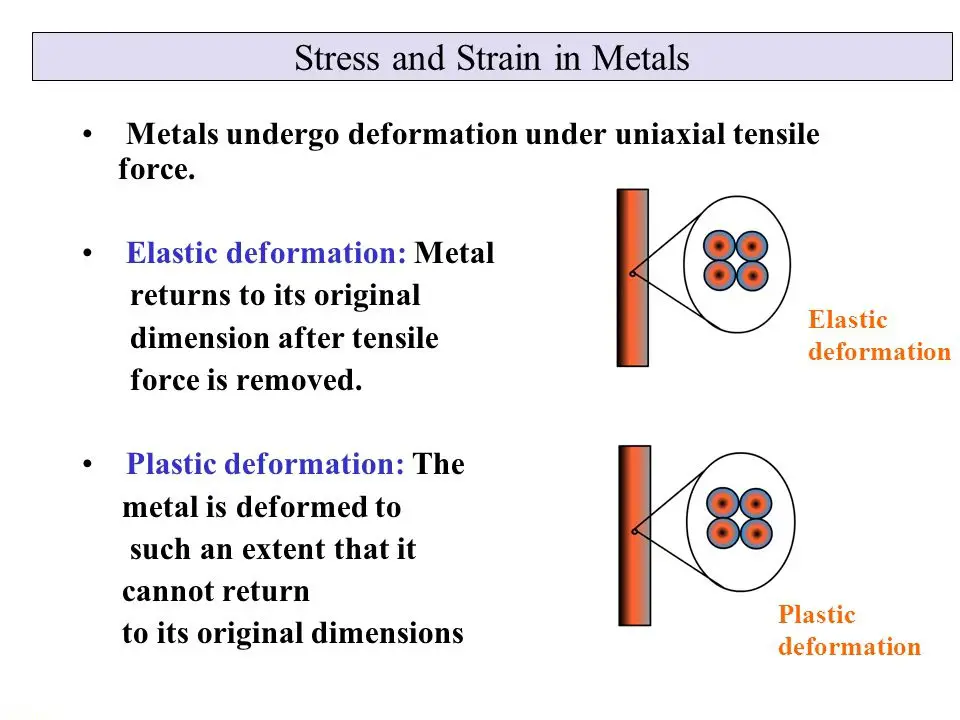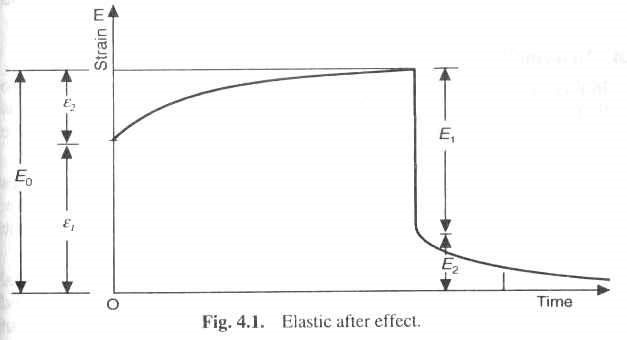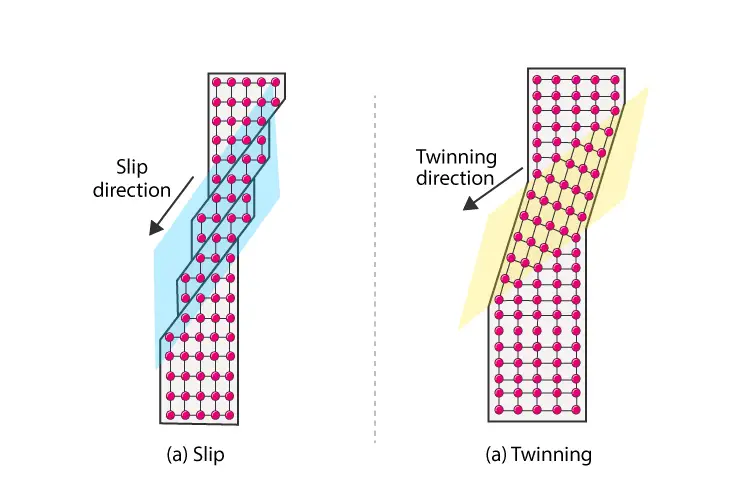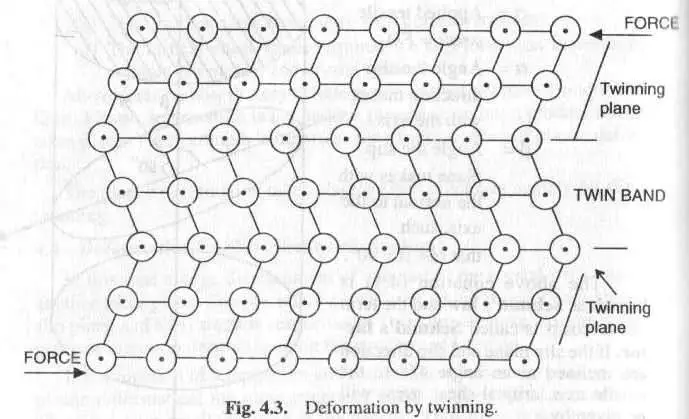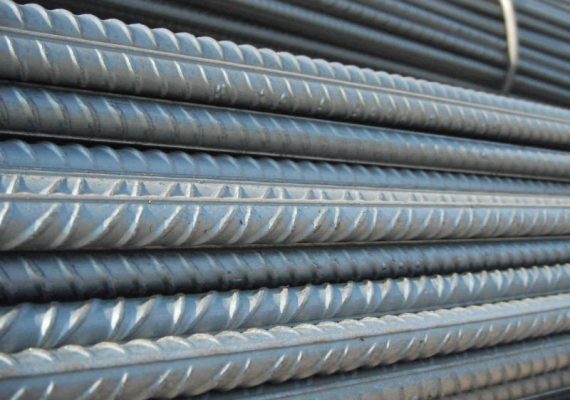Deformation Of Metals | Elastic Deformation | Plastic Deformation |Shear Deformation
Deformation Of Metals | Elastic Deformation | Plastic Deformation |Shear Deformation
Deformation of Metals
The change produced in metal without any fracture even after removal of external load is called deformation. The change can be either axial or angular in nature. The property which enables metals to deform without any fracture is called plasticity.
Plasticity of Metals
Plasticity can be defined as the ability of the materials to get deformed without rupture during the force’s application, which exceeds the yield value of the materials. When an external force is applied to a plastic metal, it undergoes first elastic deformation, after that permanent deformation, and finally fracture.
Against this, brittle material like cast iron will fracture suddenly without showing any plastic deformation. The plastic deformation of a metal or alloy depends on the following:
-
Microstructure
-
Grain size
-
Composition
An ideal material deforms without undergoing any strain (work) hardening. The stress-strain diagram for an ideal plastic body will be a straight line corresponding to the material’s yield stress.
However, in the case of certain materials, elastic deformation proceeds plastic strain resulting in a curve. Such materials are called elastoplastic bodies and are used in structural jobs.
Another property of metallic material that enables it to regain its original shape and size after removing the forces within the elastic limits is elasticity. It shows the rigidity or stiffness of the material. A stiff material requires a comparatively high load before it deforms. In elastic metal, every atom will return to its original position if the external force is removed before reaching the elastic limit.
Thus, the deformation of metal can be categorized into two.
Types of Deformations
-
Elastic deformation
-
Plastic deformation.
Tough materials will resist permanent deformation well in advance of fracture. Some materials may be tougher and can absorb high energy before fracture, e.g., alloy steels. Others may be very soft, like lead, and require less energy to deform. Copper is soft but absorbs more energy before it fractures.
Elastic Deformation
The deformation of a metallic material, which disappears totally when the external force is removed within elastic limits, is called the Elastic deformation. In principle, it follows Hook’s law; therefore, the phenomenon is reversible, and it does not change the structure of the material.
The tensile load increases the inter-atomic spacing while the compression load decreases the same. When the load is removed, the atoms return to their original position. The shape and size are regained, and the extra energy is converted to heat energy.
The strain produced is proportional to the stress. The ratio between stress and strain is known as Young’s modulus or modulus of elasticity. The ratio of lateral strain to the original strain is called Poisson’s ratio. The crystal structure of the metal is also subjected to shearing load and causes shearing strain. The ratio of shearing stress and shearing strain is called shear modulus or modulus of rigidity.
Elastic After Effect
When subjected to sudden loading and unloading, certain materials show the behavior, as shown in Fig 4.1 below. The behavior of the specimen is called Elastic after effect or delayed elasticity. Initially, there is a sudden increase in strain due to the impact load. After that it increases gradually if the load is continued. Again, if the load is removed suddenly, the strain comes down, equal to the initial increase in strain. After that it decreases slowly. Rubber is an example of this type of behavior.
If a sudden load is applied at time t = 0, strain initially shows the value of E1; after that, it increases gradually. Total strain is E0 = E1 + E2. Similarly, if the load is removed suddenly, strain drops instantaneously by E1 and after that gradually to zero, as shown in Fig 4.1, without any plastic deformation.
Plastic Deformation
Plastic deformation is observed when the stress is more than the elastic limit. It takes place in the process of slipping. The displacement of atoms during plastic deformation is permanent. The crystals do not return to their original position even after removal of the stresses. It is based on the bonding forces between the atoms. The change can vary the rate of plastic deformation in strain rate, applied stress, and temperature.
This property of plastic as drawing, rolling, pressing, stamping, and extrusion is utilized while manufacturing many products, such as rails and I-beams, drawing of wire, extrusion rivet holes, and forging shafts.
Factors responsible for plastic deformation are:
- There may be several possible slip planes within a crystal.
- The different grains may not have the same elastic stresses when they are loaded.
- The resolved shear stress varies with grain orientation.
- The critical shear stress required for slip formation depends upon crystals’ orientation and crystal planes.
The above factors show that crystalline materials do not have a unique elastic limit. Plastic deformation is not a sudden phenomenon, but a gradual initiation takes place. Yield strength is the stress for a finite number of plastic deformation.
The plastic deformation takes place by two processes, namely by slip (shear deformation) and twinning.
Deformation by Slip (Shear deformation)
In this case, a large displacement of one part of the crystal concerning another takes place. The place and direction in which it occurs are known as slip plane and slip direction. This slip may take in more than one plane or direction depending upon the structure of crystals.
It is a function of temperature and composition. When a crystal undergoes plastic deformation, the arrangement of atoms in the crystal remains the same. There is a very small variation in the density. Thus, there is no change in volume.
It is a non-reversible process. Atomic blocks do not return to the original shape after the withdrawal of the forces. The shear which produces slip is called the critical resolved shear stress. The theoretical value of shear strength is about one-sixth of shear modulus (G/6). In actual practice shear stress required to produce a slip is much smaller. Energy (E) required for the dislocation line is given by
E α L.G.b2
where L = Length of dislocation line
G = Shear modulus; b = Burger’s vector
The energy required for deformation will be minimum when the shear modulus (G) and Burger’s vector (b) are minima. Dislocations having the shortest slip vector (b) are the easiest to generate and develop for plastic deformation.
Critical resolved Shear stress
The stress required to initiate slip in a crystal is called Critical Resolved Shear Stress. The component of shear stress in the direction of slip is called “critical shear stress” and is a constant for each material and depends upon the type of material. It is affected by the rate of deformation, temperature, purity of the material, etc.; with the increase in temperature, the value of critical shear stress decreases as the material’s thermal mobility increases.
Deformation by Twinning
The sliding of one plane of atoms over the next is known as twinning. The total movement at any point is proportional to the distance from the twinning plane. Twinning differs from the slip in the sense that in twinning, each plane of atoms moves a definite distance, instead of a complete block of atoms as in the case of a slip. Each of the two parts produced by twinning is symmetrical about the twinning plane and a mirror image.
Twinning is generally caused due to impact, thermal treatment, and plastic deformation. As a result of strain or low temperature, thin lamellar twins appear when the applied stress is higher than required. These are called Newmann bands. Twinning occurs in body-centered cubic (B.C.C) and Hexagonal close-packed (H.C.P) structure.
There are two types of twinning
(i) Twinning produced due to applied stress under shock loading known as strain twins or mechanical twins.
(ii) Twinning produced as a result of annealing process known as annealing twins.
Table 4.1 Difference between slip and twinning
Twinning deformation |
Slip/Shear deformation |
|
| (a) | Each plane of atoms moves a definite distance. | Consists of a shear displacement of an entire block. |
| (b) | Twinning portion of the grain is the mirror image of the original lattice. | The slipped portion of a grain is of same orientation as that of the original grain. |
| (c) | The direction of shear is limited to that which produces the twin image | Direction of shear can be either positive or negative. |
| (d) | Stress required to produce twinning is more | Stress required to produce slip is less. |

